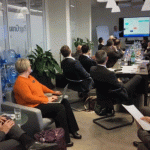 The first ever digital European FP&A Board meeting took place on September 24, 2020.
The first ever digital European FP&A Board meeting took place on September 24, 2020.
Even though it was different than the face-to-face meetings, the interest and participation only seemed to have grown. There were over 400 attendees from 30 countries from all over the globe. It was truly an international live webinar that featured presentations by industry experts.
The event was facilitated by Hans Gobin, International Board Ambassador, and sponsored by SAP and Robert Half.
Benefits of the FP&A Digitalization
Insights by Stephane Bonutto, CFO of Europe at Oerlikon Balzers.
FP&A Digitalization has great potential in any industry, so make sure that you are ready for it. In his presentation Stephane walked through the change of his organization from the intermediate phase to the leading phase of FP&A in the FP&A Analytics Maturity Model. The digitalization of the FP&A function allowed for several benefits:
faster decision making,
standardized and automated processes,
development of the backup strategy,
establishment of the Shared Service Centers,
aligned BPM across the business,
shortened forecast and budget cycles.
Stephane also emphasized the work in progress in terms of increasing automation, utilization of artificial intelligence (AI), and state of the art forecasting to truly get to the advanced phase.

Picture 1. The FP&A Analytics Maturity Model
The Power of Driver Based Planning: Deutsche Bahn case study
Insights by Tanja Schlesinger, VP Business Intelligence OneSource at Deutsche Bahn Regio AG.
Tanja presented the business case of Deutsche Bahn Regio and introduced the concept of “New Era of Continuous Enterprise Financial and Operational Planning”. It is a thought-provoking concept of ending silo approach and fully integrating the finance and operations of the company.
The project that she managed started with a simple question: “What are the major items with impact in our business?” Answering this question led to identifying and understanding key value drivers (energy cost) and its other implications such as environmental concerns and financial impact. Following the identification, the immediate next step was the capture of the data and the analysis of the vehicle utilization information for the fleet. What started with static data got captured as live data for increased accuracy in next stages.
After the analysis, the findings lead to the development and implementation of the Assistance System which required close collaboration with operations. The multiple step development was enabled with the assistance of IT programming (Data Engineers and Data Scientists).
When proper data collection and management was available, the big question became “How do we achieve the biggest energy saving? Where? When? Which vehicle?” These questions were answered by representative examples and classifications of the fleet and routes, which led to optimized driving style based on routes (custom recommendation based on analysis and factors such as weather and other key drivers).
The results of the project were impressive both financially and ecologically at 7% less energy consumption, 11.5m liter diesel and 30,000 CO2 reduction per year.
In order to successfully realize projects with business impact, you need to
focus on your organization wide agreed performance indicators, small experiments to build a use case.
set up a modern data management.
work closely with your IT and Operations departments.
Predictive/Prescriptive Analytics: The future of forecasting
Insights by Thomas Lundell, Senior Director at NetApp.
Thomas started his presentation with a memorable quote from Warren Buffett: “Forecasts usually tell us more of the forecaster than of the future”. He also offered an alternative approach to the future of forecasting. His approach focused on sort of a hybrid approach with inclusion and awareness of the human element rather than Predictive Analytics being the only end goal. The elements surrounding people with regards to forecasting such as agendas, culture, bias, and influence are still present.
Finance function could evolve over time from historical analysis to predictive analysis through use of technology and data science. Despite the advancements, Thomas argued that the predictive analysis should be not too determinant but instead be utilized to look at the gaps between the model and the traditional forecast. Therefore, the actions that need to be taken can be identified. In his experience, due to the hybrid approach, forecasts become more accurate over time, and more healthy discussions take place in final submission. The gap between forecasts, despite being large at the beginning, has also closed over time.
Some takeaways from Thomas’ presentation include the following:
Different companies require different drivers and different models to suit them.
Predictive model is complementary to management forecast rather than a replacement option.
It is important to remember to continuously evolve the model to stay relevant.
Utilizing Modern Technology for Decision Making
Insights by Eric Smit, Vice President at SAP.
Eric pointed out that the goal of any analysis is to guide value adding decision making. Unfortunately, most organizations are too occupied with visualization. This is largely due to the amount of available data and the choice of which ones to use has become overwhelming in recent years.
For example, influencing factors should not be used aggregately but more on a product, by channel, by region etc. basis. A company that produces both cereal and ice cream product lines would certainly want to use outside temperature on their forecasting, but this factor might not necessarily have an impact on cereal consumption as it does in their ice cream demand. Transitioning towards the predictive phase would make decisions more autonomous and highly accurate.
Decision making is continuously evolving; it is getting more autonomous, less isolated, and moving towards one integrated data platform. The goal is to move from “Collect and Respond” to “Predict and Act”. A technology solution that covers the whole spectrum can certainly help.
You can see the FP&A Analytics Capabilities Model below for your reference:

Picture 2. FP&A Analytics Capabilities Model
Talent Management in FP&A: Skills required for the digital era
Insights by Pascal Koth, Director at Robert Half.
Pascal provided the unique angle of the talent side of FP&A. He provided an overview of skills and abilities needed and current emphasis of the CFOs with actual data in the European region. One thing that stayed the “same” was the evolution over time of the skills in demand for FP&A profession. The top desired skills for the year were
analytical skills,
understanding of the organization,
communication.
There were also country level differences in most demanded skills. For example, where Germany favored more technical/hard skills, Belgium had more soft skills on top of the priority lists. There will be more analysis going forward for the underlying causes of the country level differences.
In addition to the in-demand skills, cost reduction, automating FP&A, business/digital transformation still rank very highly in CFOs priorities today.
In Summary
As technology keeps advancing, digitalizing FP&A function and integrating it across the organization is not out of the reach for any company. The successful companies of tomorrow will thrive by tech enabled understanding, planning and analysis.
Let us know if you have any examples from your organization on successful FP&A digitalization or specific challenges during the transition in the comments section below.
We would like to thank our global sponsors and partners SAP, Robert Half for their great support with this Digital FP&A Board.





